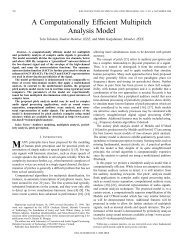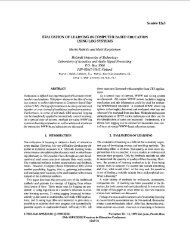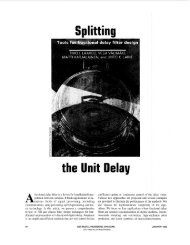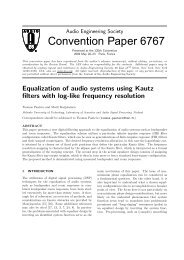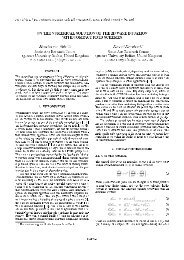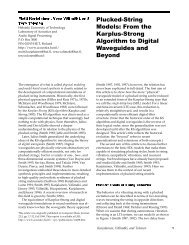Physical Modeling of Plucked String Instruments with Application to ...
Physical Modeling of Plucked String Instruments with Application to ...
Physical Modeling of Plucked String Instruments with Application to ...
You also want an ePaper? Increase the reach of your titles
YUMPU automatically turns print PDFs into web optimized ePapers that Google loves.
VALIMAKI ET AL. PAPERS3.3 Loop Filter DesignLet us denote the numera<strong>to</strong>r <strong>of</strong> Eq. (6) byIt is known that our hearing is sensitive <strong>to</strong> the change A = g(1 + al) (20)<strong>of</strong> decay rate <strong>of</strong> a sinusoid, and in practice we measurethe time constant <strong>of</strong> some 20 lowest harmonics <strong>with</strong> the and HI(<strong>to</strong>) <strong>with</strong> the numera<strong>to</strong>r removed byintent <strong>of</strong> matching the frequency response <strong>of</strong> the loopfilterfilter,Hl(Z)it is<strong>to</strong>clearthosethatdata.thereSincearewemoreuse arestrictionsfirst-order loopthan//l(<strong>to</strong>) - HI(t°)A (21)unknowns in this problem, and only an approximatesolution is possible. Then Eq. (18) can be rewritten asIn principle the loop filter should be designed basedon an audi<strong>to</strong>ry criterion, but since that would be compli- tq- 1cated, we decided <strong>to</strong> use weighted least-squares design. E = _ W(GD[IAPi(%)I - Gk]2 . (22)k=0The error function <strong>to</strong> be minimized in the magnitudeonlyapproximation can be defined as The gain g <strong>of</strong> the loop filter at low frequencies canNh-l be chosen based on the loop gain values <strong>of</strong> the lowestE = ___ W(GO[lHl(<strong>to</strong>OI - Gk]2 (18) harmonics. In many cases it is good enough <strong>to</strong> set g =k=0 Go, whereas sometimes the average <strong>of</strong> two or three lowestloop gain values gives a better result.where N h is the number <strong>of</strong> frequency points where the The value for the coefficient a I that minimizes E canloop gain Gk is approximated, % = kO0 are the central be found by differentiating Eq. (22) <strong>with</strong> respect <strong>to</strong> a 1.frequencies <strong>of</strong> the N h lowest harmonics, and W(Gk) is This yieldsa nonnegative error weighting function. It is reasonableltO choose a weighting function W_ Ut _ that gives a largerOENh - 1- 2A0 _'. W(GO01[-/1(%)1'' [IAo[/l(<strong>to</strong>0l- Gk].weight <strong>to</strong> the errorsdecaying harmonicsin the time constants <strong>of</strong> the slowlysince our hearing tends <strong>to</strong> focus onOa1 k=o Oaltheirdecay.A candidateforsucha weightingfunctionis (23)Nh-lBy substituting Eqs. (6) and (19), we can writeOE _ 2A° _ Aocos <strong>to</strong>k(1 + alcos%) -3 - Gkcos <strong>to</strong>n(1 + alcos%) -l (24)Oal k=o 1 -- GkThe aim is now <strong>to</strong> find the zero <strong>of</strong> this function. In1 practice we find a near-optimal solution in the followingW(GO - 1 - Gk' (19) way. The value <strong>of</strong> the derivative is evaluated, and dependingon the sign <strong>of</strong> the result, a I is changed by asmall increment, the derivative is evaluated again, andWe require that 0 _< Gk < 1 for all k, which is a physisoon. After the derivative has reached a very smallcally reasonable assumption since the system <strong>to</strong> be modvalue,the iteration is terminated and the final value foreled is passive and stable.a1 is used in the synthesis model. We have verifiedthe convergence <strong>of</strong> this design procedure in practice by....... analyzing signals generated using the synthesis model.0.995 data yields the same filter parameters--<strong>with</strong>in numericalaccuracy--as were used in the synthesis. Also analysis '9 Theloopfilterthatwasdesignedbasedonthe the°'99I / I [ T"_ _-- _ match <strong>with</strong> natural <strong>to</strong>nes has been found <strong>to</strong> be satisfac-·S['_°'985[ I '"'-( I_<strong>to</strong>ry in many cases. Fig. 20 illustrates the loop filter094r I I I I I design fora typical kantele <strong>to</strong>ne.0.975 It iswellunders<strong>to</strong>odthatwhena stringisput<strong>to</strong>vibra-90.97 tion by plucking it, the sound signal will lack those harmoniesthat have a node at the plucking point (see, for.0'9651 example, [17]). However, in general the string is not0 96_/ ' 015 '_'.s ' _' _'._ , _ , _ plucked exactly at the node <strong>of</strong> any <strong>of</strong> the lowest harmon-' . _.5 2 2.5 3 3.5 ics, and since the amplitude <strong>of</strong> the higher harmonics isFrequency(kHz)Fig. 20. Loop filter design for kantele. Circles--loop gains considerably small anyway, it is not possible <strong>to</strong> accu-G2 at harmonic frequencies; solid line--the magnitude re- rately detect the plucking point by simply searching forsponse [H_(z)l2. the lacking harmonics in the magnitude spectrum. An-342 d. Audio Eng. Soc., Vol. 44, No. 5, 1996 May






